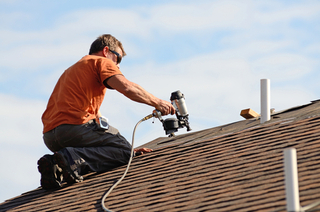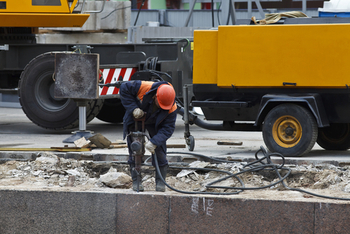Towable Air Compressors Reshape the Jobsite through Precision and Efficiency

From remodels to new construction, few technologies have had greater impact than the towable air compressor. A core component to job sites of almost every scale, air compressors have become an essential piece of construction equipment for their ability to cut time frames while boosting the quality and consistency of a wide variety of trades.
Available in five different categories, towable air compressors are broken down by outputs that range from 185 cfm to 1600 cfm. They're typically available in single-axle and tandem axle, mounted atop 2 to 6 wheels. They also come in four-wheel steerable and even those without running gear.
Each has been designed to easily support tooling and equipment on even the most remote construction or manufacturing site. Common configurations and the tools they support include:
| Towable Air Compressor Tools | ||||||
|---|---|---|---|---|---|---|
| Function* | Horsepower | Engine | ACFM | PSI | Wheels | Estimated Cost |
| Small Tools (2-10 CFM) | ||||||
| Air Drills, Air Sanders | 80 hp | Diesel | 210 | 150 psig | 2 | $8,000 - $9,500 |
| Impact Wrenches, Nailers and Staplers | 140 hp | Diesel | 375 | 100 - 150 psig | 2 | $12,000 - $16,000 |
| Mid-Range Tools (30-80 CFM) | ||||||
| Rivet Busters, Pavement Breakers, Large Drills | - | Diesel | 750 | 70 - 150 psig | 4 | $32,000 - $37,000 |
| Chipping Hammers, Backfill, Tampers/Sand Rammers | - | Diesel | 825 | 70 -150 psig | 4 | $37,000 - $42,000 |
| Heavy-Duty Tools (60 - 200 plus CFM) | ||||||
| Jackhammers | - | Diesel | 1300 | 70 -150 psig | 6 | $60,000 - $135,000 |
| Rock Drills, Diggers | - | Diesel | 1600 | 70 - 155 psig | 6 | $60,000 - $140,000 |
* Note: Compressor and tool pairings are estimated based on standard CFM requirements for each tool. Check with tool manufacturer for the proper level of support when connecting multiple tools to a single air compressor.
Maximizing the impact of every tool
Towable air compressors often include electronic engine control and a pneumatic inlet valve that manages inlet from 0% to 100%. At the same time, many models leverage extensive monitoring systems that enable operators to adjust efficiency aspects including:
- Discharge pressure and temperature
- Ambient air temperature
- Aftercooler air temperature
- Engine speed
- Volts
- Fuel usage rate
This capability not only increases productivity, it also extends the life of the tool by ensuring that it continues to run within its peak operational range.
Choosing the best towable air compressors
As indicated in the graph above, the air compressor you select will be directly related to the construction equipment it's meant to power and the number of hookups you require. Here are three recommendations based on standard tooling requirements:
Small tools
Look for a versatile portable screw air compressor that provides heavy-duty performance in the lightest weight possible. With an output that ranges between 80 to 140 hp, models that fall within this range (like the S-energy line from Sullair) should offer a working pressure of at least 150 psi and include airend efficiencies that produce maximum air with minimal fuel consumption. Given the close proximity and enclosed spaces in which many operators are forced to work, noise is a factor too. Look for compressors that operate at low noise levels - a max sound level of 76 db(A) at 23 ft. is currently the best.
Quality units are manufactured with a polymer canopy that resists scratches and denting, retaining value well into the future, and steel flooring that protects the motor in extreme environments. The best compressors for this output range also include a thermostatically-controlled valve that automatically adjusts the temperature of the compressed air in comparison to the temperature in the surrounding environment. It also includes an anti-frost valve that delivers further operating efficiency while preventing tool freeze-up.
Mid-range tools
Taking the next step up, portable compressors that have been designed for mid-range tooling and equipment (such as the 15-hp rotary screw compressor from Campbell Hausfeld) should include an extra-large fuel tank, supporting at least 80 lbs. of diesel fuel and ideally 120 lbs. Overflow protection is another big plus, providing quick, safe refilling on any jobsite. Given the size and weight of the unit, look for a compressor that's mounted on a torsion bar suspension system and oversized tires. This will ensure easy transport on paved and unpaved surfaces alike.
Similar to its smaller counterpart, mid-range compressors should feature a steel chassis and housing that's manufactured from galvanized steel to protect the motor, airend, and other critical parts from environmental and airborne contaminates. To achieve the highest level of efficiency, look for a unit that offers a high-capacity cold start battery. This will help to guarantee reliability in even the most remote settings.
Heavy-duty tools

At the top of the range, towable air compressors that offer a capacity of 1300 to 1600 cfm (like the 327-hp portable compressor from Kaeser) are built to support heavy-duty demands in extreme environments. Given the range of operational demands often inflicted on units of this caliber, temperature is a key consideration. Look for a compressor that's capable of operating in the widest range of ambient temperatures - a ceiling of 122 degrees F is common among this group.
Often used in mining and other enclosed spaces, sound levels are again a consideration. The best portable compressors within this range should operate at sound levels that are as low as 76 db(A) at 23 feet. Depending on your intended use, models in this range also offer available upgrades that include extended working pressures of up to 205 psig, an aftercooler, and skid mounts.
Ready to Compare Air Compressors Price Quotes?